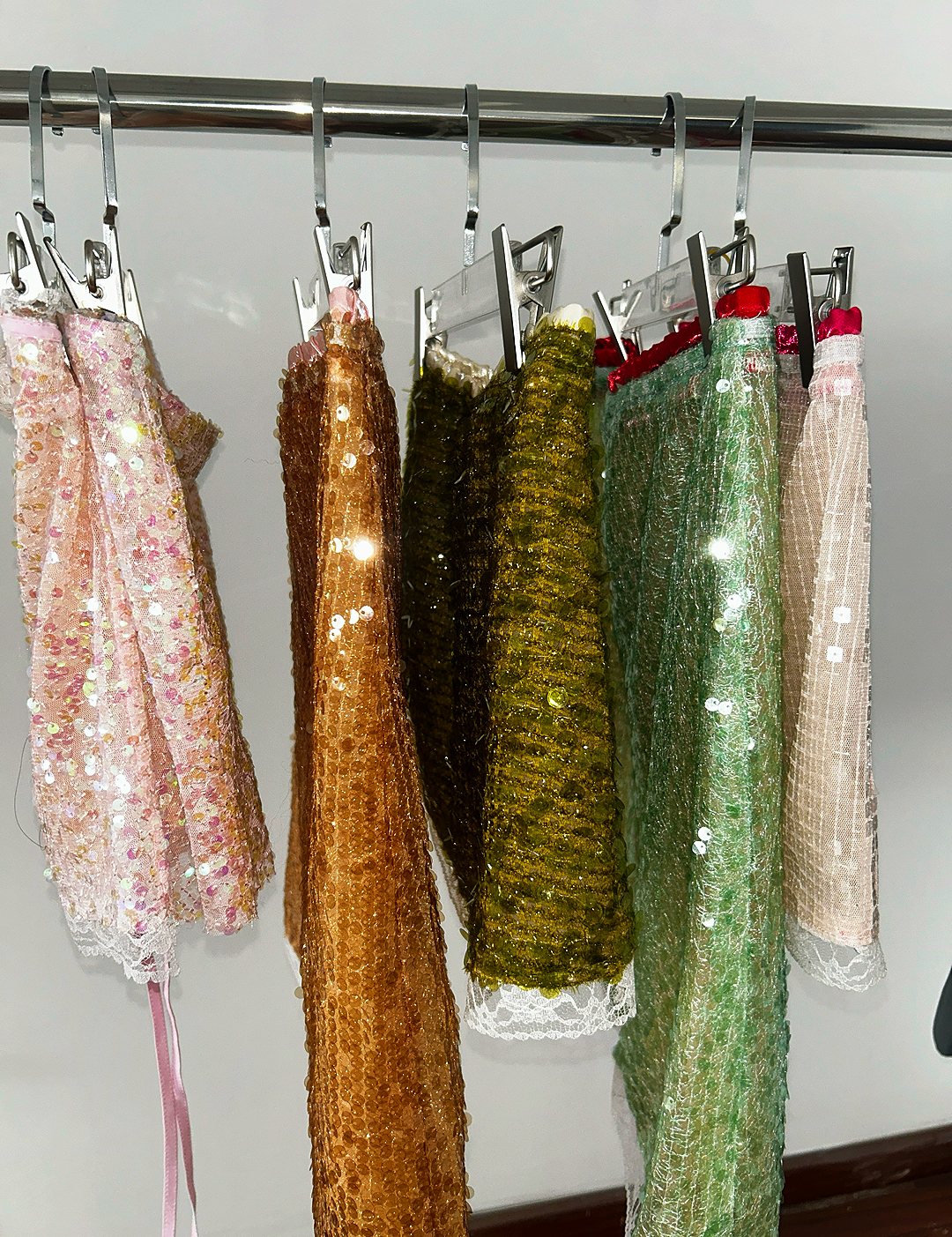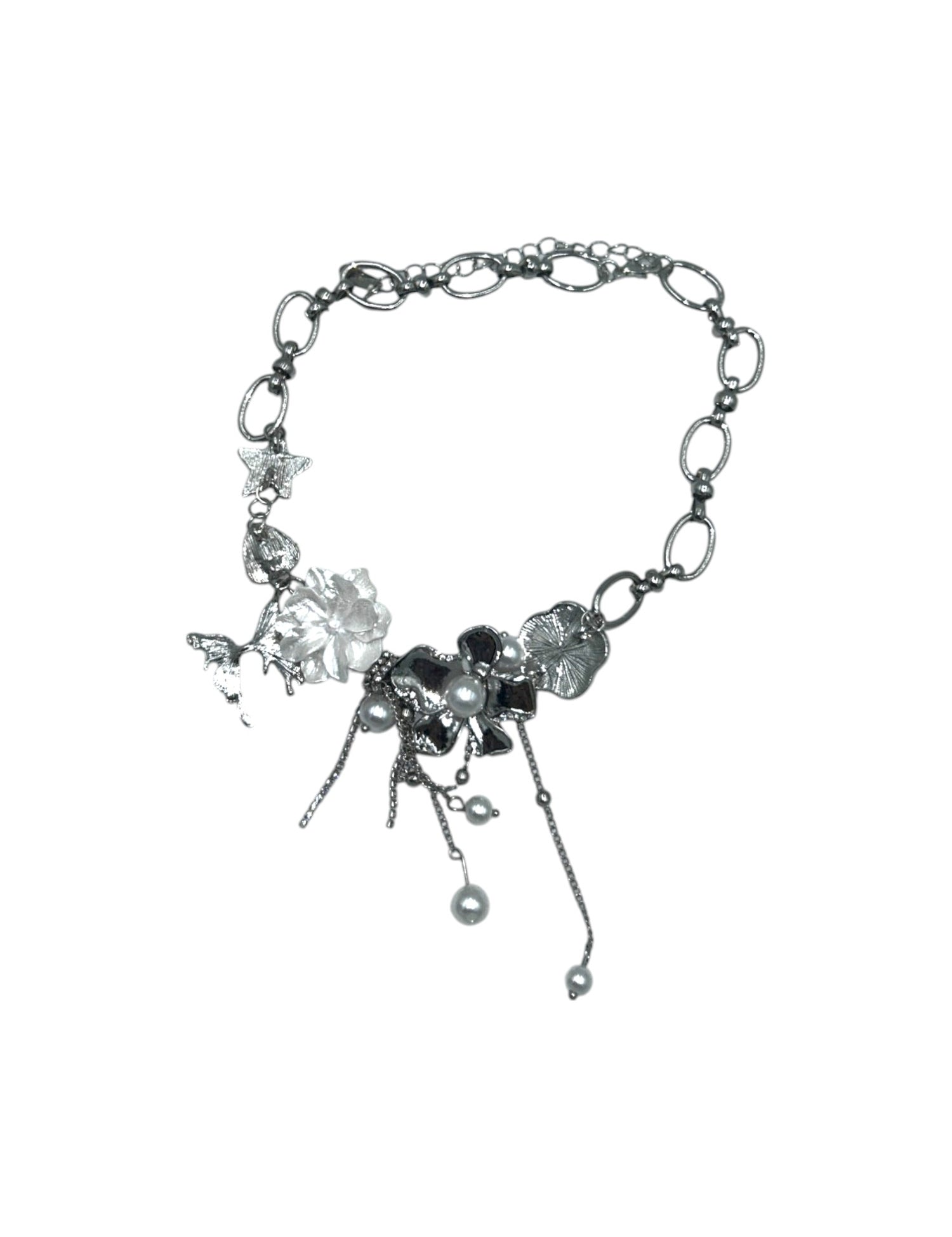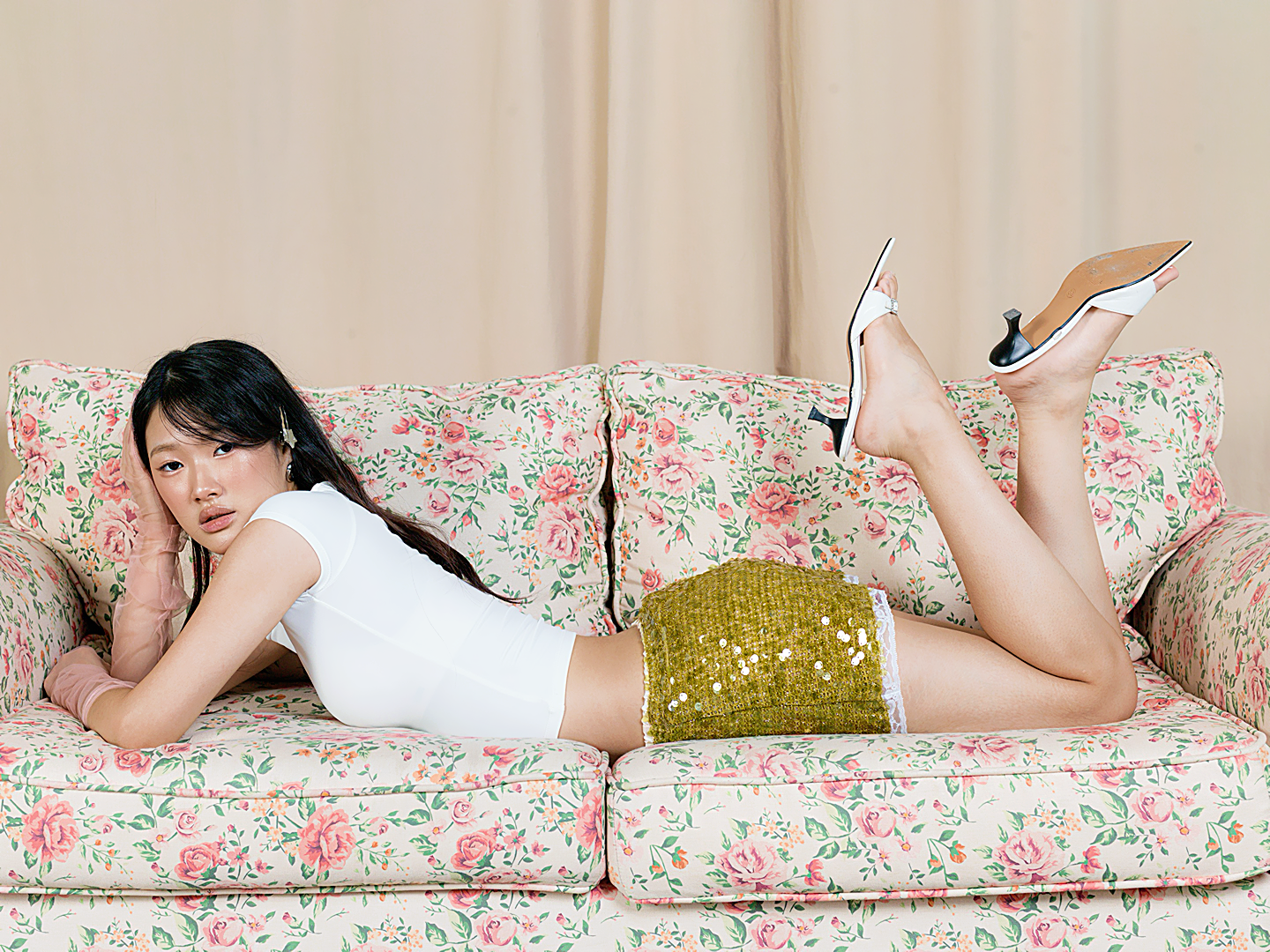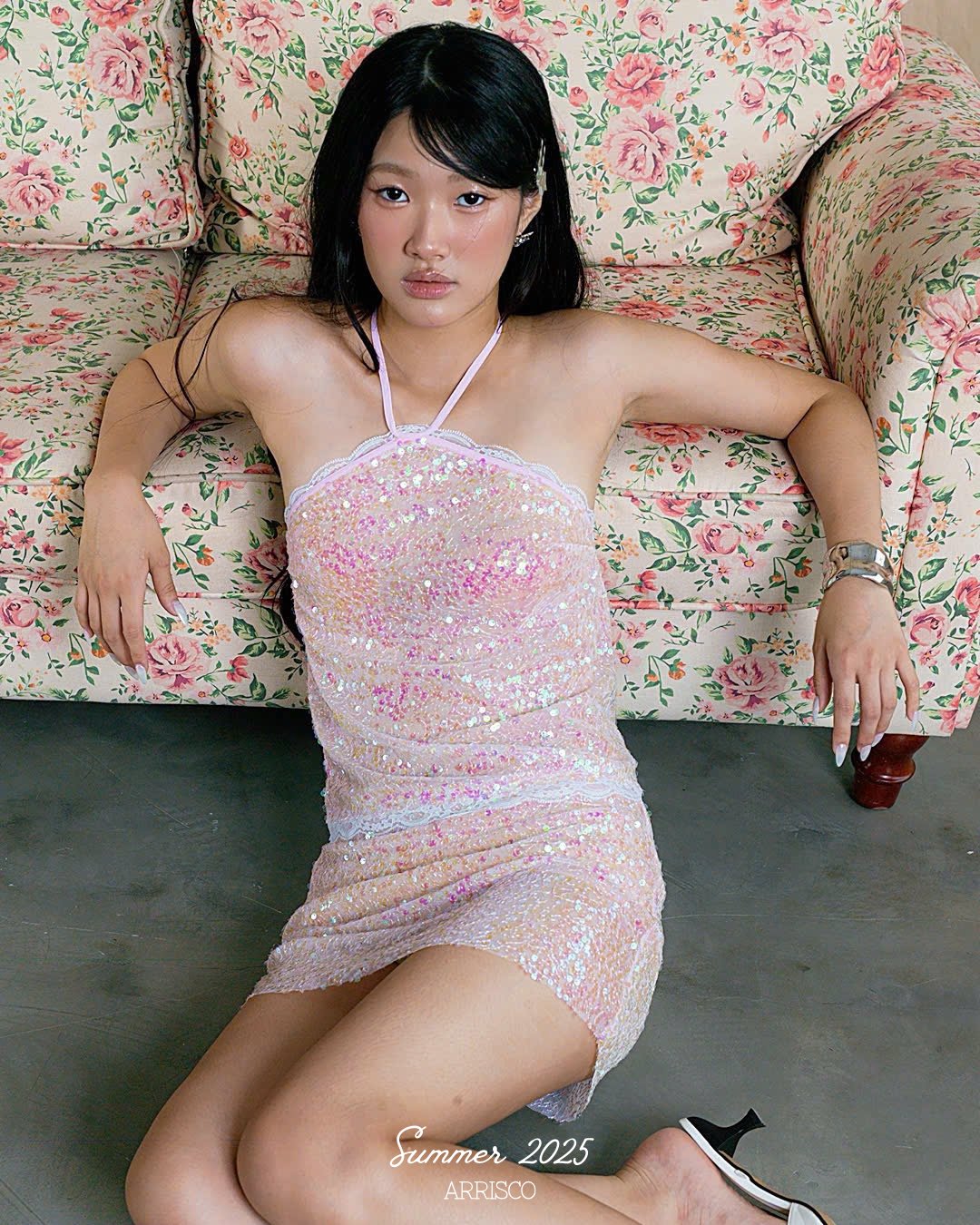Welcome to the exciting world of sustainable fashion! If you're here searching for sustainable online clothing stores, you're already part of a massive shift toward a more mindful—and seriously stylish—way of dressing. This is where your journey to a wardrobe that truly reflects your values begins.
Your Journey Into Sustainable Fashion Starts Here
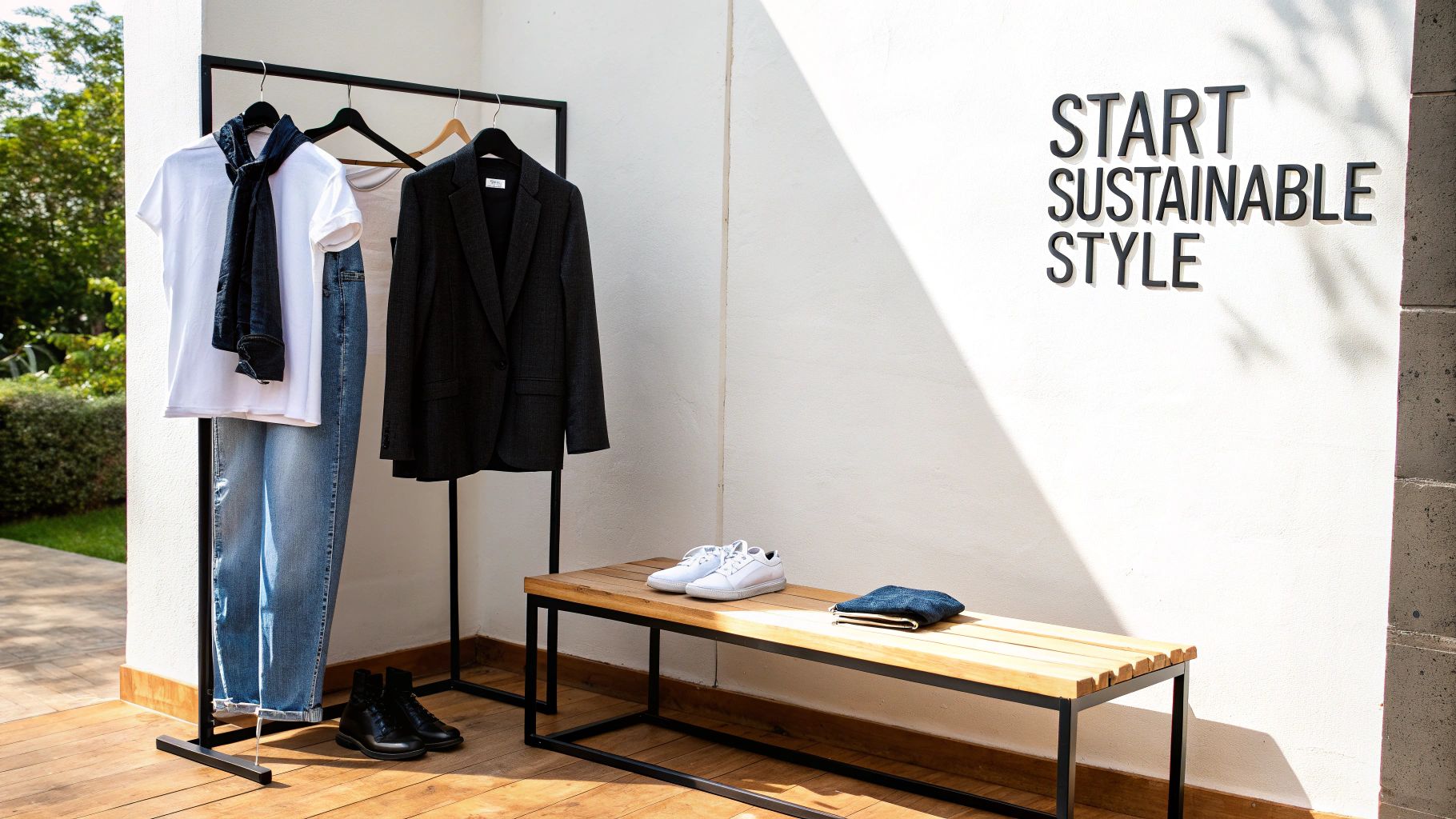
Let's be real: fashion is way more than just clothes. It's a statement. Every time you choose to support an ethical brand, you're casting a vote for a healthier planet and for the fair treatment of the amazing people who make our garments.
And this isn't some fleeting trend; it's a full-blown movement. The growing demand for apparel that's both eco-friendly and ethically made is completely shaking up the industry for the better.
The global sustainable fashion market was valued at around $8.04 billion and is expected to explode to $58.03 billion by 2035. That's not just a number—it’s proof that consumers like you are demanding more transparency and responsibility. You can read more about the sustainable fashion market growth and see just how big this is getting.
This guide is your new best friend for navigating it all. We're going to cut through the noise and confusing jargon to give you the confidence to make choices you can feel incredible about. Let's turn your personal style into a genuine force for good.
The Core of Conscious Choices
So, what really sets thoughtful, sustainable fashion apart from the dizzying, disposable world of fast fashion? It all comes down to a few core ideas that champion timelessness and mindfulness over short-lived trends. A great first step is learning how to make more intentional choices, and our guide on how to build a capsule wardrobe is the perfect place to get inspired.
To really get a feel for the two approaches, here’s a quick comparison.
Sustainable Fashion vs Fast Fashion At a Glance
| Attribute | Sustainable Fashion | Fast Fashion |
|---|---|---|
| Pace & Scale | Slow, thoughtful production | Rapid, mass production |
| Material Sourcing | Eco-friendly, organic, recycled | Synthetic, resource-intensive |
| Garment Lifespan | Designed for longevity | Meant to be disposable |
| Labor Practices | Fair wages, safe conditions | Often exploitative, low wages |
| Environmental Impact | Minimal footprint, circularity | High pollution and waste |
This table really puts into perspective how different the philosophies are. One is about building a better future, and the other is about feeding a constant cycle of consumption.
At its heart, the sustainable fashion movement is driven by these powerful principles:
- Quality Over Quantity: It’s all about investing in beautifully made pieces that you'll love for years, not just a season. This breaks the endless cycle of buying and tossing.
- Ethical Production: This means ensuring every single person in the supply chain—from the farmer growing the cotton to the person sewing the seams—is treated with dignity and paid a fair, living wage.
- Environmental Stewardship: This is a big one. It’s about choosing materials and processes that are kind to our planet. Think organic cotton that uses far less water or natural dyes that don't pollute our rivers and oceans.
When you embrace these ideas, you're doing so much more than just buying a new top. You're actively supporting an entire ecosystem built on respect for people and the planet.
So, What Really Makes a Clothing Store Sustainable?
Ever wonder what truly makes an online clothing store sustainable? It’s a question that goes way beyond just using organic cotton or sticking an "eco-friendly" label on a t-shirt. Real sustainability is a deep-seated philosophy that’s woven into every single thread of a business, and it all comes down to three core pillars working in harmony.
Think of it like building a beautiful, sturdy house. You need a solid foundation (environmental responsibility), strong walls (ethical labor), and a smart roof built to last for generations (circular design). If any one of those is shaky, the whole structure is at risk.
Environmental Impact: The Foundation
First things first, let's talk about our planet. Genuinely sustainable brands are borderline obsessed with shrinking their environmental footprint at every single stage. It all kicks off with the materials they choose.
For instance, conventional cotton is a notoriously thirsty crop, guzzling massive amounts of water and often grown with a cocktail of pesticides. Organic cotton, on the other hand, uses far less water and zero toxic chemicals. This commitment doesn't stop there—it carries through the entire process, from using non-toxic dyes that keep our waterways clean to powering production with renewable energy. It’s all about respecting the earth's resources, not just taking from them.
Ethical Labor: The Heart of the Brand
A piece of clothing can't be called sustainable if the people who stitched it together aren't treated with dignity and respect. This is the ethical labor pillar, and frankly, it's non-negotiable. It means guaranteeing safe working conditions, completely banning child labor, and—this is a big one—paying a fair living wage.
A living wage isn't the bare legal minimum; it's an income that allows a worker to actually support their family and live with security. Brands who walk this walk are open about their factories and often partner with organizations that certify their ethical practices. This focus on people is a key difference, something you can dig into more by understanding the contrast between slow fashion vs fast fashion.
Circular Design: A Smarter Future
Finally, we have circular design. Picture a forest ecosystem where nothing is wasted—every fallen leaf nourishes the soil for new growth. That's the exact idea here. Instead of the old "take-make-waste" model of fashion, circular design creates clothing that is meant to be durable, easily repaired, and eventually recycled.
This approach is all about crafting high-quality pieces you'll love for years, not just a season. It also means getting creative with recycled materials and designing garments that can be taken apart and reborn as something new when they've lived a full life.
But beyond the tangible stuff like fabrics and factories, what truly sets a sustainable store apart is its story. It's their ability to share their mission and values, tapping into the power of brand storytelling to connect with people who care. This transparency is what builds real trust and lasting loyalty.
The shift to online shopping has been a massive catalyst for this movement. In fact, online retail now makes up about 39.8% of the sustainable fashion market! Why? Because it gives brands a direct line to you, allowing them to share every detail of their story and prove their credentials. It’s this digital connection that empowers us all to make better, more informed choices.
Decoding Materials and Certifications
Ever feel like you need a PhD just to understand a clothing tag? With all the eco-labels and funky fabric names out there, you're definitely not alone! But here's the good news: once you crack the code, it's actually incredibly empowering. Think of this as your personal decoder ring for figuring out what makes the clothing at the best sustainable online clothing stores a genuinely better choice for our planet.
It all boils down to the raw materials. The fabric a brand chooses is one of its biggest decisions, and it has a massive ripple effect on everything from water consumption to chemical pollution. When you spot a garment made from one of these superstar materials, you can feel confident you’re making a great choice.
The A-List of Sustainable Fabrics
Let’s talk about the real heroes of the textile world. These materials are fan favorites for a reason—they not only look fantastic and feel amazing to wear, but they also treat the earth with the kindness it deserves.
- Organic Cotton: Picture that perfectly soft, worn-in cotton tee you love, but make it even better. Organic cotton is grown without all the nasty toxic pesticides and synthetic fertilizers, and it uses way less water than the conventional kind. It's a win for farmers, ecosystems, and your skin.
- Linen & Hemp: These two are the undisputed champs of natural fibers. Both plants are incredibly hardy, requiring very little water and no pesticides to thrive. Better yet, they actually help enrich the soil they grow in. How cool is that?
- TENCEL™ Lyocell: This is where brilliant innovation meets Mother Nature. Made from sustainably sourced wood pulp in a "closed-loop" system, TENCEL™ is famous for its ridiculously silky feel. The production process is just as impressive, recycling over 99% of the water and solvents used.
- Recycled Polyester (rPET): While the goal is to reduce plastic overall, rPET gives existing plastic—like old water bottles—a second chance at life. This clever process keeps tons of plastic out of our landfills and oceans and uses far less energy than creating brand-new polyester from scratch.
Want to get even more familiar with the fabrics in your closet? You can take a much deeper dive by unraveling fashion fabrics in our go-to guide. It’s the perfect resource for becoming a true textile pro.
This infographic really brings it all together, showing how the best brands build their foundation on three core pillars: the environment, fair labor, and timeless design.
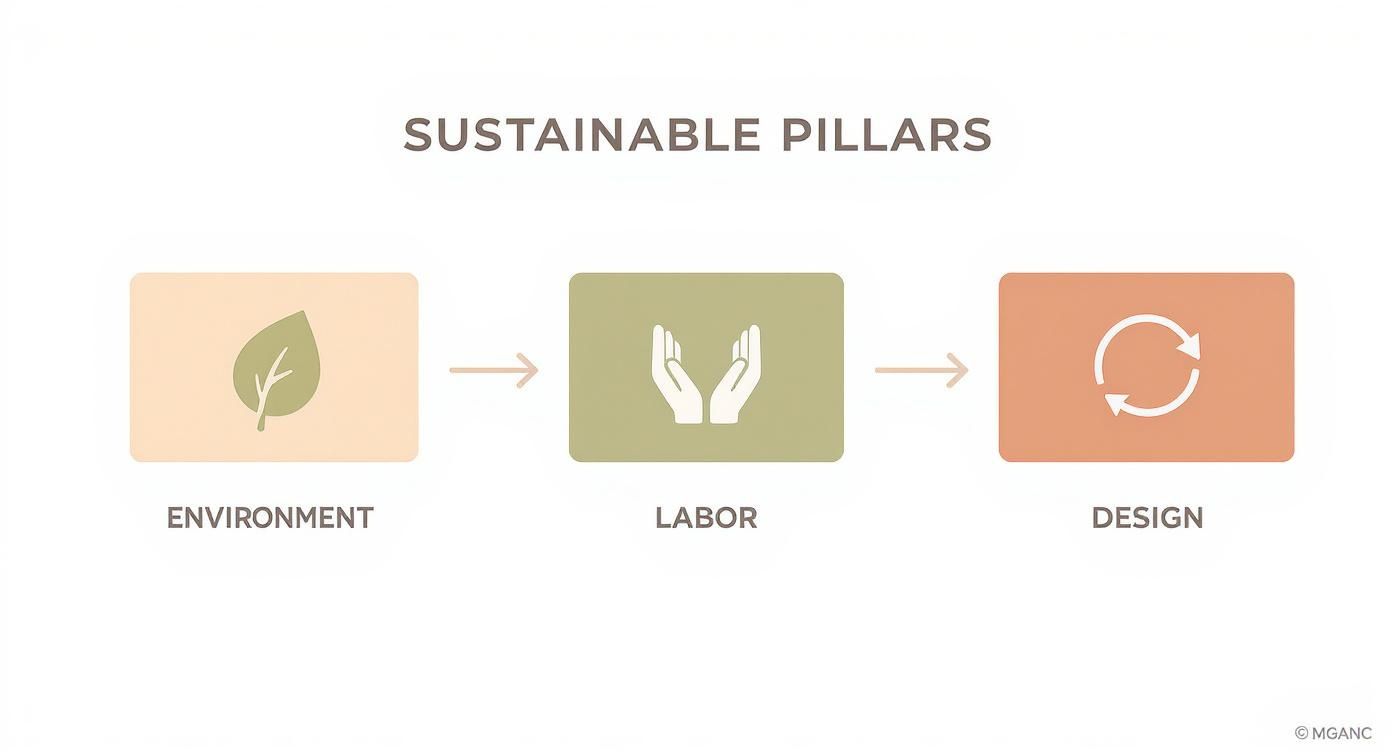
As you can see, amazing materials are just one piece of the puzzle. How a brand treats its workers and designs its clothes is just as crucial.
Your Guide to Trustworthy Certifications
Alright, so a brand says it uses great materials. But how do you really know they're walking the talk? This is where third-party certifications become your best friend. These official-looking labels are like a trusted expert giving a brand their stamp of approval.
Navigating all the different logos can be a bit overwhelming, but you really only need to recognize a few key players to shop with confidence. We've put together a simple table to break down the most common certifications you'll see and what they actually mean.
Common Sustainability Certifications and What They Mean
| Certification | What It Guarantees | Look for This Logo |
|---|---|---|
| GOTS (Global Organic Textile Standard) | This is the gold standard for organic textiles. It ensures the entire process, from harvesting the raw materials to the final product, is 100% organic and meets strict social and environmental criteria. | GOTS logo |
| Fair Trade Certified™ | This one is all about people. It guarantees that workers received fair wages, have safe working conditions, and are empowered through community development funds. It’s about ethical treatment from start to finish. | Fair Trade Certified™ seal |
| B Corp Certification | This is a big deal. A B Corp is legally required to consider the impact of its decisions on its workers, customers, community, and the environment. It's a holistic certification that proves a business is a true force for good. | Certified B Corporation logo |
When you see one of these logos, you can breathe a sigh of relief. It means an independent organization has done the heavy lifting and verified that the brand is truly committed to making a positive impact. It’s your shortcut to shopping with a clear conscience
How to Spot Greenwashing and Find Ethical Brands
Diving into the world of sustainable online clothing stores can feel like you're trying to crack a code. On one hand, you have brands doing incredible, honest work. On the other, you've got companies that have perfected the art of greenwashing—making themselves look a whole lot greener than they actually are.
This is where you get to put on your detective hat!
Greenwashing is masterfully vague. It’s full of feel-good buzzwords like "eco-conscious" or "earth-friendly" that sound great but have no real substance behind them. Think of it like a snack labeled "all-natural." Sounds healthy, right? But what does it really mean? Without any solid proof, these are just marketing words designed to make us feel better about what we're buying.
Real sustainability, however, is all about transparency. Genuinely ethical brands aren't afraid to show you the receipts—they want you to see exactly how their clothes are made, from the farm to your closet.
Your Greenwashing Detection Checklist
So, how do you tell the difference between the good guys and the greenwashers? It all comes down to asking a few simple, yet powerful, questions. A brand that's walking the walk will have the answers right there on their website, usually in a section called "Sustainability" or "Our Impact."
Here’s your cheat sheet for what to look for:
- Do they name their factories? Honest brands are proud of who they work with and aren't shy about listing factory names and locations. If they're keeping their manufacturing partners a secret, that's a huge red flag.
- Is there a recent sustainability report? Real-deal brands often publish reports (usually every year) packed with actual data on their progress—things like carbon emissions, water usage, and what they pay their workers.
- Are material claims backed by proof? If a tag says "organic cotton," look for the GOTS logo. If it boasts about "recycled polyester," see if it's certified by the Global Recycled Standard (GRS). No proof, no purchase.
- What's the deal with wages? It’s one thing to pay the legal minimum wage; it's another thing entirely to pay a living wage that actually supports a person and their family. Look for commitments to the latter, or partnerships with programs like Fair Trade Certified™.
Vague language is the best friend of greenwashing. Specificity and third-party verification are its worst enemies. If a brand's sustainability page feels more like a poem than a report, it's time to dig deeper.
By asking these questions, you stop being just a shopper and become a conscious consumer who demands better.
From Detective to Confident Shopper
Learning to spot the real deal is an amazing feeling. It’s not about being perfect, but about making better, more informed choices every time you shop. The more you look for transparency and certifications, the easier it becomes to instantly spot the brands that are genuinely committed to a better future.
Every time you do this little bit of detective work, you’re sending a powerful message that you support businesses that value both people and the planet. To keep building these skills, our guide to help you embrace ethical fashion and transform your wardrobe is packed with even more tips for creating a closet you can truly feel good about. You’ve got this
Inspiring Sustainable Online Clothing Stores to Know
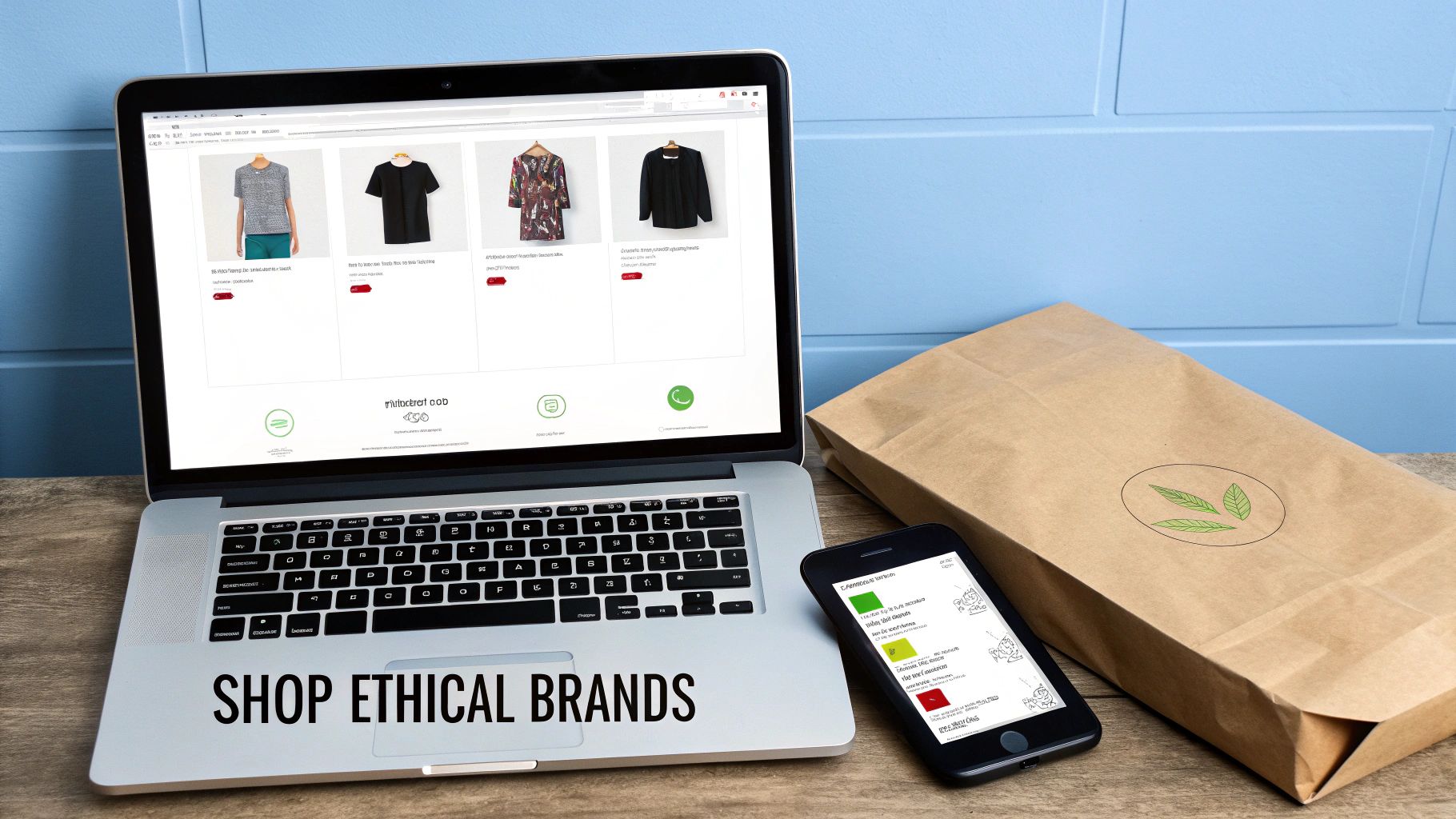
Alright, now for the really fun part—shining a spotlight on the incredible brands that are actually walking the walk. It's one thing to talk about sustainability, but seeing it in action is where the magic happens. These sustainable online clothing stores are living proof that you never have to sacrifice an ounce of style to make a positive impact.
They’re doing so much more than just selling clothes. They are building communities, telling incredible stories, and proving that fashion can be a force for good. Each one brings something special to the table, whether it's radical transparency in their supply chain or mind-blowing innovations with recycled materials.
And this isn't some niche movement anymore; it's a global shift. Europe is currently a major hub, accounting for about 23.1% of the market, but the momentum is spreading like wildfire. Just look at the Asia Pacific region, which is expected to leap from $1.6 billion to a staggering $4.5 billion by 2034! If you want to dive deeper, you can discover more insights about the global sustainable fashion market and see how shoppers everywhere are changing their habits.
So, let's get into some of the amazing brands leading the charge.
Brands That Walk the Walk
I’ve pulled together a list of companies that truly embody the principles we’ve been talking about. They cover a great range of styles and prices, proving that ethical fashion really is for everyone.
Patagonia
You can't talk about sustainable brands without mentioning this absolute legend. Patagonia is an undisputed pioneer, weaving environmental activism into the very fabric of its identity. They're famous for their "Ironclad Guarantee," which encourages you to repair your gear instead of tossing it, and they don't hide a thing about their supply chain. Their devotion to recycled materials and Fair Trade Certified™ sewing is second to none.
ISTO
Based in Portugal, ISTO is a masterclass in transparency. Their whole philosophy is beautiful in its simplicity: create timeless, exceptionally made essentials and show you exactly what they cost to produce. On every product page, they break down the costs for materials, labor, and transport. It’s an empowering approach that helps you see the real value in what you’re buying.
NAZ
Another gem from Portugal, NAZ crafts gorgeous, cozy womenswear from natural fibers like recycled wool and organic cotton. What really makes them stand out is their incredibly detailed annual sustainability report. It covers everything—from CO2 emissions to the positive impact they have on their local community. That's a level of honesty that builds serious trust.
These brands show us that sustainability is a journey of continuous improvement, not a destination. They are constantly innovating, questioning their own practices, and pushing the entire industry forward.
More Than Just New Clothes
Let’s not forget that true sustainability is also about celebrating what we already have! The pre-loved market is absolutely booming, and it's a fantastic way to give your wardrobe a refresh without adding to the demand for new production. Diving into online vintage clothing boutiques is one of the most stylish—and impactful—ways to join the circular fashion movement.
Here are a few more innovators making waves:
- ColieCo Lingerie: This brand is the definition of slow fashion. Operating on a zero-waste, made-to-order model from their small studio, they ensure every single piece is crafted with intention.
- Zouri Shoes: Talk about inspiring! Zouri actually rescues plastic trash from the Portuguese coast and transforms it into the soles of their awesome vegan sneakers. It’s circular design at its best.
- A Line: This Portuguese label is all about longevity. They design timeless womenswear built to last and even have a program to repair or recycle your garments when they finally reach the end of their life.
These incredible stores are completely rewriting the fashion rulebook. They’re proving that a beautiful wardrobe and a better world can—and should—go hand in hand.
Got Questions About Sustainable Fashion? We've Got Answers.
Diving into a more mindful way of dressing is an amazing step, but let's be real—it can bring up a lot of questions. The world of sustainable online clothing stores can feel like a maze at times, so I want to clear the air on some of the most common things people wonder about. This is your go-to guide for building a wardrobe that not only looks great but feels right.
We're going to break down everything from the price tag to garment care, giving you the straightforward, practical info you need to shop with total confidence.
"But Isn't Sustainable Fashion Just More Expensive?"
This is hands-down the number one question I hear, and it's a totally valid one. While you might notice a higher initial price on a sustainably made piece compared to its fast-fashion equivalent, the key is to shift how you think about its value. It’s not about the upfront cost; it’s about the long-term investment.
Ethical brands are pouring money into top-notch, durable materials and, crucially, paying the people who make our clothes a fair, livable wage. The result? Gorgeous clothing that’s actually built to last for years, not just a few weeks.
A great way to think about it is "cost per wear." That $30 fast-fashion top that starts fraying after five washes? It cost you $6 every single time you wore it. Now, consider a $90 ethically crafted top that you'll wear at least 30 times. That brings your cost per wear down to just $3—and you get the joy of wearing a far superior piece of clothing.
Honestly, by investing in fewer, better items, a lot of people discover they save money in the long run. You're building a collection of pieces you truly adore, not just a closet overflowing with disposable trends.
How Can I Build a Sustainable Wardrobe Without Breaking the Bank?
You absolutely can! Sustainability isn't just about buying new ethical pieces. In fact, the most sustainable move you can make is to wear what you already own. Start by "shopping" your own closet—get creative, rediscover old favorites, and try out some new combinations. You'd be surprised what you can come up with.
When you do decide you need something new, remember that being a conscious consumer has many faces:
- Become a Thrifting Pro: Secondhand is your secret weapon. Dive into local consignment shops, browse online resale platforms, and organize clothing swaps with friends. It's the best way to find unique, pre-loved gems with a story.
- Play the Waiting Game: Have your eye on a special piece from a favorite ethical brand? A little patience can go a long way. Many sustainable online clothing stores offer seasonal sales that make their collections much more accessible.
- Think Versatility First: Build your wardrobe around timeless, multipurpose staples. A classic organic cotton tee or a fantastic pair of ethically made jeans will serve you so much better than a fleeting micro-trend you'll be tired of next month.
The whole point is mindful consumption, not just endless shopping.
What's the Best Way to Care for My Sustainable Clothes?
Taking proper care of your clothes is a total game-changer. It extends the life of your garments by years, which saves you money and is one of the easiest ways to shrink your environmental footprint. And the best part? It's usually incredibly simple.
For most natural and eco-friendly fabrics, the golden rule is to wash in cold water and line dry whenever you can. This one small habit does wonders—it preserves the fabric's structure and color while drastically cutting down on your energy consumption. Always give the care label a quick glance, but steering clear of harsh detergents and high-heat dryers will keep your beautiful pieces looking fantastic season after season.
How Can I Tell if a Brand Is Genuinely Transparent?
This is where you get to channel your inner detective. Real transparency isn't about vague, feel-good statements; it's about specific, verifiable proof.
Look for brands that are excited to share the details of their entire supply chain, right down to the names and locations of their factories. An annual impact or sustainability report is another huge green flag—it shows they're tracking their progress and holding themselves accountable. Finally, keep an eye out for third-party certifications like Fair Trade and B Corp. These act as an independent stamp of approval, validating a brand's claims. If a company's sustainability page is all fluff and no facts, that tells you everything you need to know.
Here at Arrisco, we believe style and substance belong together. We’re incredibly passionate about bringing you beautifully designed collections crafted with integrity and innovation. Come explore our seasonal edits and discover fashion you can truly feel great about at https://shoparrisco.com.

